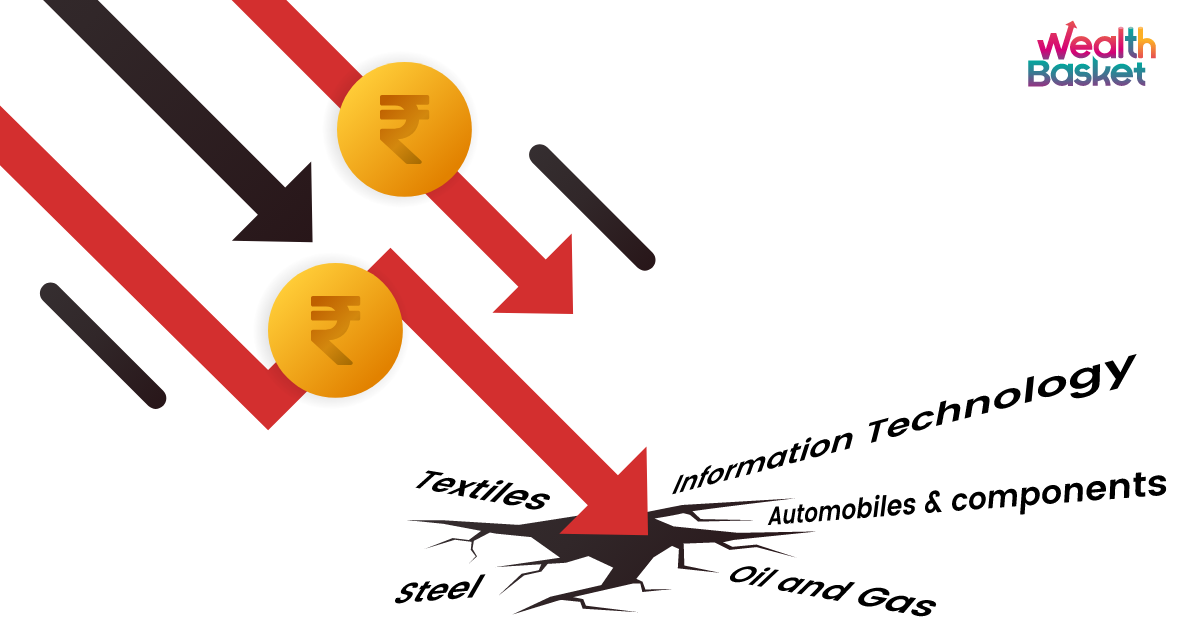In 2022, for the first time ever, the Indian rupee depreciated beyond ₹80 against the US dollar. In this blog, we look at the reasons for the Indian rupee’s depreciation and how it affects the economy and different sectors of the economy.
Why is the rupee depreciating?
With all else equal, the Indian rupee depreciates when:
- The supply of the Indian rupee increases in the foreign exchange market
- The demand for other currencies increases
In 2022, the reasons for the rupee’s depreciation are capital outflows, high import costs and a strong US dollar. A significant contributor to the high import costs was the rising crude oil prices that surged to $120/barrel in March.
When capital flows out of India, foreign investors sell Indian assets and exchange the rupee received for their currency. This increases the supply of the Indian rupee and the demand for other currencies in the foreign exchange market.
Similarly, when India’s imports increase, India would offer more rupees which would then be exchanged for other currencies. This too increases the supply of the Indian rupee and the demand for other currencies in the foreign exchange market.
In 2022, geopolitical tensions rose due to Russia invading Ukraine. So, the US dollar enjoyed high demand due to its status as a safe-haven currency. Another reason for higher demand for the dollar would be the rise in interest rate income on bonds after the US Federal Reserve raised interest rates.
Check out this article for a more in-depth explanation of why the rupee is falling.
How does the rupee depreciation affect India?
When the rupee depreciates, its purchasing power in other countries drops. So, imported goods and services will become more expensive. If India can produce substitutes for the products it imports, the rise in prices of imported goods might help boost domestic industries. But, if India is unsuccessful in substituting expensive imported products, it would have to deal with higher import costs, leading to further drops in the rupee’s value.
Another effect of the depreciating rupee is that it makes India’s exports cheaper. If the price of something drops, its demand should normally increase. This can help export-oriented companies increase their sales. Moreover, increased exports mean the demand for the Indian rupee increases and the supply of other currencies also increases. This might have the effect of increasing the value of the Indian rupee.
The overall impact of the rupee’s depreciation on the Indian economy would depend on how the export-oriented and import-dependent sectors will respond.
How does the rupee depreciation affect different industries?
The effect rupee’s depreciation will have on a particular industry depends on how export-oriented and dependent on imports it is. Here we look at some sectors impacted by the rupee’s depreciation.
- Oil and Gas
- Information Technology
- Textiles
- Automobiles and auto components
- Steel
Oil and Gas
Let’s start by addressing the elephant in the room. 85% of India’s oil and roughly 50% of its gas needs are met through imports. In 2022, we saw crude oil prices rise and the rupee depreciate. Oil importers would be negatively affected by all this. Domestic oil producers on the other hand have a chance to charge higher prices while their costs remain largely unchanged.
Information Technology (IT)
During 2021-22, India’s software service exports stood at $171.9 billion, growing 15.9% from a year earlier. The US is the top destination for Indian IT exports accounting for 42.5% of exports in 2021-22. If the Indian IT companies can keep up this trend, they will benefit from the Indian rupee depreciating against the US dollar.
Textiles
India is one of the largest producers of textiles and the 6th largest exporter of textiles. In 2022, the USA and the European Union were the top destinations for Indian textile exports accounting for 27% and 18% of the exports, respectively. The textile industry might gain from the depreciating Indian rupee if the demand from the USA and the EU remains strong.
Automobiles and auto components
In FY2022, India exported 56 lakh automobiles, up 36% on a year-on-year basis. India exports 24% of the total number of vehicles produced worldwide. Thus, due to its high exports, the Indian automobile industry might benefit from the rupee’s depreciation.
During 2021-22, India’s auto part imports were ₹1.36 lakh crores. But, around 41% of the imports come from China and Germany. Hence, investors of companies that import auto parts might need to keep an eye on the rupee-euro and the rupee-renminbi exchange rates and not just the rupee-dollar exchange rate. In the same period of 2021-22, India exported ₹1.41 trillion worth of auto components, rising 43.5% in a year. If export-oriented auto component makers can keep up with this trend, they might benefit from the rupee’s depreciation.
Steel
During 2021-22, India’s net exports of finished steel products stood at 8.82 million tonnes (MT). On a year-on-year basis, India’s finished steel product exports rose by more than 25%, while its imports dropped by 1.68%. So, the steel sector might be able to take advantage of lower prices due to the Indian rupee falling in value.
Final Thoughts
We generally perceive the news of the Indian rupee falling as negative due to the increased import costs. But, trying to understand whether the stocks they are investing in are import-dependent, export-oriented or involved in making products that compete with currently imported goods would help gauge the impact of changes in the exchange value of the Indian rupee.
FAQs
The rupee’s depreciation would be a positive for export-oriented sectors and sectors producing currently imported products. For importers, however, the rupee’s depreciation would mean an increase in costs.
The Indian economy can benefit from the Indian rupee’s depreciation if the domestic industries can replace imported products and export-oriented companies can boost exports, but otherwise, the economy would suffer due to high import costs.
When the value of the Indian rupee increases, imports become cheaper, and exports become more expensive. This can be beneficial in times of high import costs. Companies that get their raw materials from abroad would benefit, while companies that compete with imported products and export-oriented companies would suffer.
When a currency, say the Indian rupee, depreciates, Indian exports become cheaper for consumers abroad as they have to pay less in their currency to pay Indian exporters in rupees for the same product. When the price of a product decreases, normally, its demand increases. Thus, currency depreciation can boost exports.


















